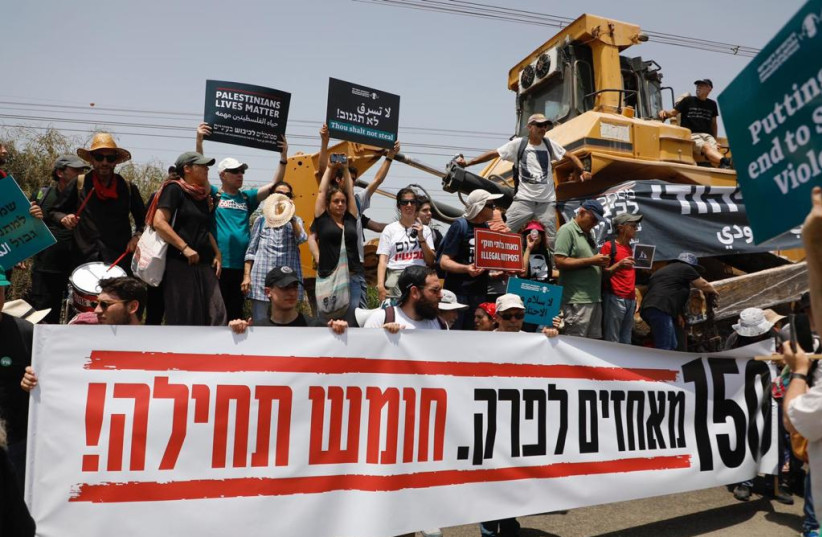In a move seen as a first step toward rebuilding four northern Samaria settlements evacuated in 2005, the state plans to advance legalization for the Homesh Yeshiva on the site of one of those destroyed communities in Area C of the West Bank.
“This is a landmark step in our 17-year battle against the crime of the evacuation,” MK Limor Son Har-Melech (Otzma Yehudit) tweeted.
"This is a landmark step in our 17 years battle against the crime of the evacuation."
Limor Son Har-Melech
She spoke out after the state informed the High Court of Justice of the plan during a Monday hearing on a petition calling for the yeshiva to be evacuated. It was filed in 2019 by the left-wing NGO Yesh Din on behalf of Palestinians from the nearby village of Burka who own most of the land on that hilltop.
“In this government, we will work to fully restore the Homesh settlement and to the other three evacuated communities – Sa-Nur, Ganim and Kadim,” Har-Melech tweeted.

Netanyahu vows to keep the promise in the Israeli coalition deal to legalize Homesh yeshiva
The new government had agreed in its coalition deals to authorize the Homesh Yeshiva, which struggled to remain at the site for more than 17 years by holding classes and study sessions in modular tents on the hilltop.
The IDF has evacuated it dozens of times, and the yeshiva has been rebuilt after each demolition.
At Monday’s court hearing, the state’s attorney let Homesh supporters and the judges know that Prime Minister Benjamin Netanyahu intended to keep his promise to legalize Homesh.
In a vaguely worded statement, the state’s attorney explained that according to the coalition agreements, policy changes would be made with respect to Disengagement and the “normative situation in regard to the governance of the place.”
This will be done as part of the intention of the upper echelon “to ensure the continuation of full governance there, while making the necessary adjustments for this activity to be in accordance with all laws,” the state’s attorney said.
These new policies will change the state’s position with respect to the Homesh petition, the state’s attorney said.
The state has spoken in the past of the yeshiva’s illegal presence on the hilltop and of its intention to evacuate the modular seminary at the appropriate time.
In light of the government’s new policies, the state asked for and received a three-month extension to present its revised position to the court.
The judges granted the extension, even though they cautioned the state at the hearing that revised government policies were unlikely to be relevant in this case.
At issue is a 2013 High Court of Justice ruling that recognized the Homesh hilltop as belonging to private Palestinian owners and granted them access to farm their property.
The original Homesh settlement was built in 1978, one year before the well-known, precedent-setting Elon Moreh ruling that forbade settlement construction on private Palestinian property.
Supreme Court President Esther Hayut, who headed the three-member judiciary panel, asked the state, “How do you plan to overcome the fact that this [the Homesh hilltop] is private Palestinian land?”
Justice Uzi Vogelman also underscored the point that Homesh was private Palestinian property, adding that the court had “not heard the state claim that private land can be used since the Elon Moreh ruling.”
The court later asked the state to explain why the IDF had not evacuated those who had trespassed on the property, when it submitted its written response in 90 days.
Its use of the term “trespassers” referred to the Homesh Yeshiva and other Israeli supporters who have gone to the site.
It also asked for an explanation as to why the Palestinian landowners had not been allowed access to the site.
Yesh Din welcomed the court’s response, noting as the judges had that a government repeal of the Disengagement Law in northern Samaria “will not change the fact that this is privately owned Palestinian lands.” Equally important, it said, is that after four years and five hearings, “the state will also be required to justify why it does not allow free and safe access to the land owners to their property.”
During the 2005 Disengagement, Israel destroyed 21 settlements in the Gaza Strip and four in northern Samaria. The Gaza pullout also included a military withdrawal, making it difficult to restore those communities.
The land in northern Samaria, however, remained under IDF military rule but became closed military zones forbidden to Israeli civilians. Out of the four former settlements, only Homesh was built on private Palestinian land.
Evacuees and opponents of the 2005 Disengagement have focused their energies on rescinding the Disengagement Law in northern Samaria as a symbolic victory over what they eventually hope will be a return to Gaza.
Samaria Regional Council head Yossi Dagan, himself a Sa-Nur evacuee who has led the movement to rescind Disengagement, lauded the government’s stand in court.
“The [four] northern settlements were uprooted by a malicious hand,” he said, but they remained under Israeli control in Area C “due to their security and strategic importance” to the state, which only underscores the “injustice and absurdity” of what happened in 2005.
“Every day and night since the evacuation we have dreamed of returning and rebuilding the settlements,” Dagan said. “The time has come to correct the injustice [and] to repeal the criminal Disengagement Law.”
